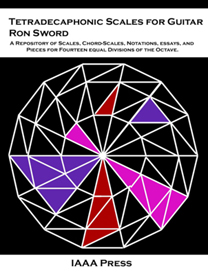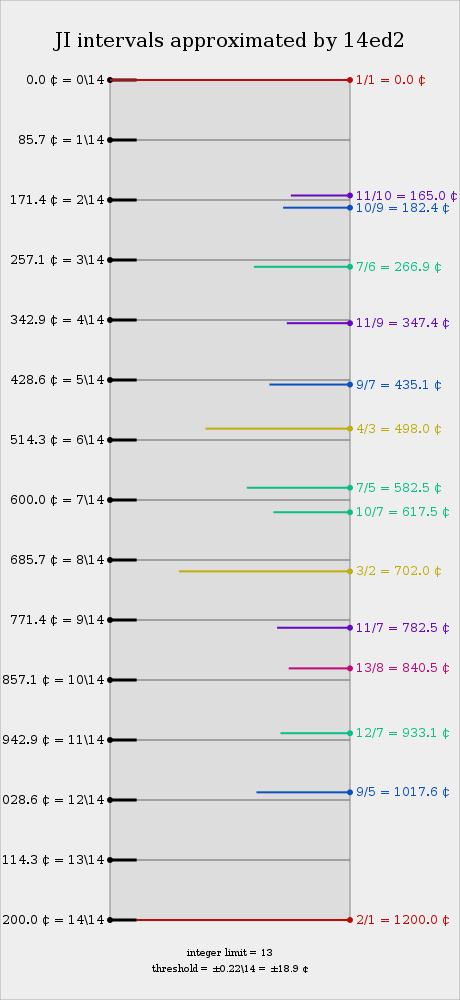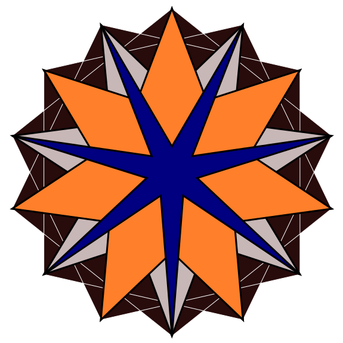14edo
| ← 13edo | 14edo | 15edo → |
14 equal divisions of the octave (abbreviated 14edo or 14ed2), also called 14-tone equal temperament (14tet) or 14 equal temperament (14et) when viewed under a regular temperament perspective, is the tuning system that divides the octave into 14 equal parts of about 85.7 ¢ each. Each step represents a frequency ratio of 21/14, or the 14th root of 2.
Theory
The character of 14edo does not well serve those seeking low-limit JI approaches, with the exception of 5:7:9:11:17:19 (which is quite well approximated, relative to other JI approximations of the low-numbered edos). However, the ratios 7/5, 7/6, 9/7, 10/7, 10/9, 11/7, 11/9, and 11/10 are all recognizably approximated, and if you accept that 14edo offers approximations of these intervals, you end up with a low-complexity, high-damage 11-limit temperament where the commas listed later in this page are tempered out. This leads to some of the bizarre equivalences described in the second "Approximate ratios" column in the table.
14et has quite a bit of xenharmonic appeal, in a similar way to 17et, on account of having three types of 3rd and three types of 6th, rather than the usual two of 12et. Since 14et also has a recognizable 4th and 5th, this makes it good for those wishing to explore alternative triadic harmonies without adding significantly more notes. It possesses a triad-rich 9-note mos scale of 5L 4s, wherein 7 of 9 notes are tonic to a subminor, supermajor, and/or neutral triad.
14edo contains an omnidiatonic scale that can replace the standard diatonic scale, allowing for recognizable triadic harmony using the chords 6:7:9 and 14:18:21, as well as a neutral chord which can be seen as 2:sqrt(6):3.
Prime harmonics
| Harmonic | 2 | 3 | 5 | 7 | 11 | 13 | 17 | 19 | 23 | 29 | 31 | |
|---|---|---|---|---|---|---|---|---|---|---|---|---|
| Error | Absolute (¢) | +0.0 | -16.2 | +42.3 | -26.0 | -37.0 | +16.6 | -19.2 | -40.4 | -28.3 | -1.0 | -30.7 |
| Relative (%) | +0.0 | -18.9 | +49.3 | -30.3 | -43.2 | +19.4 | -22.4 | -47.1 | -33.0 | -1.2 | -35.9 | |
| Steps (reduced) |
14 (0) |
22 (8) |
33 (5) |
39 (11) |
48 (6) |
52 (10) |
57 (1) |
59 (3) |
63 (7) |
68 (12) |
69 (13) | |
Subsets and supersets
Since 14 factors into primes as 2 × 7, 14edo contains 2edo and 7edo as subsets.
Notation
Ups and downs notation
| Steps | Cents | Approximate Harmonics |
Approximate Ratios 1 [note 1] |
Approximate Ratios 2 [note 2] |
Approximate Ratios 3 [note 3] |
Ups and downs notation | Interval Type | Audio | ||
|---|---|---|---|---|---|---|---|---|---|---|
| 0 | 0.000 | 1 | 1/1 | 1/1 | 1/1 | unison | 1 | D | Unison | |
| 1 | 85.714 | 67 | 20/19, 19/18, 18/17 | 28/27, 22/21, 21/20 | up-unison, down-2nd |
^1, v2 | ^D, vE | Narrow Minor 2nd | ||
| 2 | 171.429 | 71 | 11/10, 10/9, 19/17 | 12/11, 11/10, 10/9, 9/8 | 11/10, 10/9 | 2nd | 2 | E | Neutral 2nd | |
| 3 | 257.143 | 37 | 22/19, 20/17 | 8/7, 7/6 | 15/13, 7/6 | up-2nd, down-3rd |
^2, v3 | ^E, vF | Subminor 3rd | |
| 4 | 342.857 | 39 | 17/14, 11/9 | 6/5, 11/9, 5/4 | 11/9 | 3rd | 3 | F | Neutral 3rd | |
| 5 | 428.571 | 41 | 22/17, 14/11, 9/7 | 14/11, 9/7 | 14/11, 9/7 | up-3rd, down-4th |
^3, v4 | ^F, vG | Supermajor 3rd | |
| 6 | 514.286 | 43 | 19/14 | 4/3, 15/11, 11/8 | 4/3 | 4th | 4 | G | Wide 4th | |
| 7 | 600.000 | 91 | 7/5, 10/7 | 7/5, 10/7 | 7/5, 10/7 | up-4th, down-5th |
^4, v5 | ^G, vA | Tritone | |
| 8 | 685.714 | 95 | 28/19 | 16/11, 22/15, 3/2 | 3/2 | 5th | 5 | A | Narrow 5th | |
| 9 | 771.429 | 25 | 14/9, 11/7, 17/11 | 14/9, 11/7 | 14/9, 11/7 | up-5th, down-6th |
^5, v6 | ^A, vB | Subminor 6th | |
| 10 | 857.143 | 105 | 18/11, 28/17 | 8/5, 18/11, 5/3 | 18/11 | 6th | 6 | B | Neutral 6th | |
| 11 | 942.857 | 55 | 17/10, 19/11 | 12/7, 7/4 | 12/7, 26/15 | up-6th, down-7th |
^6, v7 | ^B, vC | Supermajor 6th | |
| 12 | 1028.571 | 29 | 19/34, 9/5, 20/11 | 16/9, 9/5, 20/11, 11/6 | 9/5, 20/11 | 7th | 7 | C | Neutral 7th | |
| 13 | 1114.286 | 61 | 17/9, 36/19, 19/10 | 40/21, 21/11, 27/14 | up-7th, down-8ve |
^7, v8 | ^C, vD | Wide Major 7th | ||
| 14 | 1200.000 | 2 | 2/1 | 2/1 | 2/1 | 8ve | 8 | D | Octave | |
- ↑ Based on treating 14edo as a 2.7/5.9/5.11/5.17/5.19/5 subgroup temperament; other approaches are also possible.
- ↑ Based on treating 14edo as an 11-limit temperament of ⟨14 22 32 39 48] (14c).
- ↑ Nearest 15-odd-limit intervals by direct approximation.
Sagittal notation
This notation uses the same sagittal sequence as 9-EDO, is a subset of the notations for EDOs 28 and 42b, and is a superset of the notation for 7-EDO.

Ivor Darreg's notation
Ivor Darreg wrote in this article:
The 14-tone scale presents a new situation: while one might use ordinary sharps and flats in addition to conventional naturals for the notes of the 7-tone-equal temperament, it would be misleading and confusing to do so, because there is a 7-tone circle of fifths (admittedly quite distorted) already notatable and nameable as F C G D A E B in the usual manner. But there is no 14-tone circle of fifths. There is simply a second set of 7 fifths in a circle which does not intersect the with the first set. Thus is we think of B-flat and B, or B-natural and F-sharp, the 14-tone-system interval would NOT be a fifth of that system and would not sound like one, since B F would be the very same kind of distorted fifth that C G or A E happens to be in 7 or 14. Our suggestion is to call the new notes of 14, the second set of 7, F* C* G* D* A* E* B*, and use asterisks or arrows or whatever you please on the staff. Or just number the tones as for 13.
The following chart (made by TDW) shows this recommendation as "standard notation" as well as a proposed alternative.
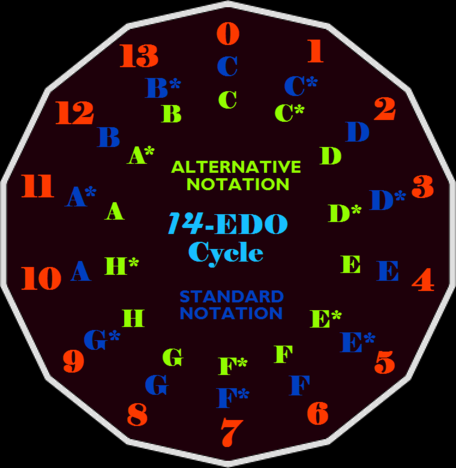
|
| Intervallic Cycle of 14 steps Equal per Octave |
Chord names
Ups and downs can be used to name 14edo chords. Because every interval is perfect, the quality can be omitted, and the words major, minor, augmented and diminished are never used. Alterations are always enclosed in parentheses, additions never are. An up or down immediately after the chord root affects the 3rd, 6th, 7th, and/or the 11th (every other note of a stacked-3rds chord 6-1-3-5-7-9-11-13).
0-4-8 = C E G = C = C or C perfect
0-3-8 = C vE G = Cv = C down
0-5-8 = C ^E G = C^ = C up
0-4-7 = C E vG = C(v5) = C down-five
0-5-9 = C ^E ^G = C^(^5) = C up up-five
0-4-8-12 = C E G B = C7 = C seven
0-4-8-11 = C E G vB = C,v7 = C add down-seven
0-3-8-12 = C vE G B = Cv,7 = C down add seven
0-3-8-11 = C vE G vB = Cv7 = C down-seven
For a more complete list, see Ups and downs notation #Chords and Chord Progressions.
Approximation to JI
Selected just intervals by error
Selected 13-limit intervals
Regular temperament properties
| Subgroup | Comma list | Mapping | Optimal 8ve stretch (¢) |
Tuning error | |
|---|---|---|---|---|---|
| Absolute (¢) | Relative (%) | ||||
| 2.3.7 | 49/48, 2187/2048 | [⟨14 22 39]] | +6.52 | 4.64 | 5.38 |
| 2.3.7.11 | 33/32, 49/48, 243/242 | [⟨14 22 39 48]] | +7.58 | 4.42 | 5.12 |
Uniform maps
| Min. size | Max. size | Wart notation | Map |
|---|---|---|---|
| 13.7306 | 13.9173 | 14cf | ⟨14 22 32 39 48 51] |
| 13.9173 | 13.9970 | 14c | ⟨14 22 32 39 48 52] |
| 13.9970 | 14.0196 | 14 | ⟨14 22 33 39 48 52] |
| 14.0196 | 14.0702 | 14e | ⟨14 22 33 39 49 52] |
| 14.0702 | 14.1875 | 14de | ⟨14 22 33 40 49 52] |
| 14.1875 | 14.1959 | 14deff | ⟨14 22 33 40 49 53] |
| 14.1959 | 14.3087 | 14bdeff | ⟨14 23 33 40 49 53] |
Rank-2 temperaments
Commas
14et tempers out the following commas. This assumes the val ⟨14 22 33 39 48 52].
| Prime limit |
Ratio[note 1] | Monzo | Cents | Color name | Name |
|---|---|---|---|---|---|
| 3 | 2187/2048 | [-11 7⟩ | 113.69 | Lawa | Whitewood comma, apotome |
| 5 | 27/25 | [0 -3 2⟩ | 133.24 | Gugu | Bug comma, large limma |
| 5 | 2048/2025 | [11 -4 -2⟩ | 19.55 | Sagugu | Diaschisma |
| 7 | 21/20 | [-2 1 -1 1⟩ | 84.47 | Zogu | Chroma |
| 7 | 36/35 | [2 2 -1 -1⟩ | 48.77 | Rugu | Mint comma, septimal quartertone |
| 7 | 49/48 | [-4 -1 0 2⟩ | 35.70 | Zozo | Sempahoresma, slendro diesis |
| 7 | 1728/1715 | [6 3 -1 -3⟩ | 13.07 | Triru-agu | Orwellisma |
| 7 | 10976/10935 | [5 -7 -1 3⟩ | 6.48 | Satrizo-agu | Hemimage comma |
| 7 | (30 digits) | [47 -7 -7 -7⟩ | 0.34 | Trisa-seprugu | Akjaysma |
| 11 | 99/98 | [-1 2 0 -2 1⟩ | 17.58 | Loruru | Mothwellsma |
| 11 | 243/242 | [-1 5 0 0 -2⟩ | 7.14 | Lulu | Rastma |
| 11 | 385/384 | [-7 -1 1 1 1⟩ | 4.50 | Lozoyo | Keenanisma |
| 13 | 91/90 | [-1 -2 -1 1 0 1⟩ | 19.13 | Thozogu | Superleap comma, biome comma |
| 13 | 676/675 | [2 -3 -2 0 0 2⟩ | 2.56 | Bithogu | Island comma |
- ↑ Ratios longer than 10 digits are presented by placeholders with informative hints.
Octave stretch or compression
14edo benefits from octave stretch as harmonics 3, 7, and 11 are all tuned flat. 22edt, 36ed6 and 42zpi are among the possible choices.
What follows is a comparison of stretched-octave 14edo tunings.
- 14edo
- Step size: 85.714 ¢, octave size: 1200.0 ¢
Pure-octaves 14edo approximates all no-5s harmonics up to 16 within 37.0 ¢.
| Harmonic | 2 | 3 | 4 | 5 | 6 | 7 | 8 | 9 | 10 | 11 | 12 | |
|---|---|---|---|---|---|---|---|---|---|---|---|---|
| Error | Absolute (¢) | +0.0 | -16.2 | +0.0 | +42.3 | -16.2 | -26.0 | +0.0 | -32.5 | +42.3 | -37.0 | -16.2 |
| Relative (%) | +0.0 | -18.9 | +0.0 | +49.3 | -18.9 | -30.3 | +0.0 | -37.9 | +49.3 | -43.2 | -18.9 | |
| Steps (reduced) |
14 (0) |
22 (8) |
28 (0) |
33 (5) |
36 (8) |
39 (11) |
42 (0) |
44 (2) |
47 (5) |
48 (6) |
50 (8) | |
| Harmonic | 13 | 14 | 15 | 16 | 17 | 18 | 19 | 20 | 21 | 22 | 23 | 24 | |
|---|---|---|---|---|---|---|---|---|---|---|---|---|---|
| Error | Absolute (¢) | +16.6 | -26.0 | +26.0 | +0.0 | -19.2 | -32.5 | -40.4 | +42.3 | -42.2 | -37.0 | -28.3 | -16.2 |
| Relative (%) | +19.4 | -30.3 | +30.4 | +0.0 | -22.4 | -37.9 | -47.1 | +49.3 | -49.2 | -43.2 | -33.0 | -18.9 | |
| Steps (reduced) |
52 (10) |
53 (11) |
55 (13) |
56 (0) |
57 (1) |
58 (2) |
59 (3) |
61 (5) |
61 (5) |
62 (6) |
63 (7) |
64 (8) | |
- Step size: 85.759 ¢, octave size: 1200.6 ¢
Stretching the octave of 14edo by around half a cent results in improved primes 3, 7 and 11, but a worse prime 13. This approximates all no-5s harmonics up to 16 within 34.9 ¢. Its 13-limit WE tuning and 13-limit TE tuning both do this.
| Harmonic | 2 | 3 | 4 | 5 | 6 | 7 | 8 | 9 | 10 | 11 | 12 | |
|---|---|---|---|---|---|---|---|---|---|---|---|---|
| Error | Absolute (¢) | +0.6 | -15.3 | +1.3 | -42.0 | -14.6 | -24.2 | +1.9 | -30.5 | -41.4 | -34.9 | -14.0 |
| Relative (%) | +0.7 | -17.8 | +1.5 | -49.0 | -17.1 | -28.2 | +2.2 | -35.6 | -48.3 | -40.7 | -16.3 | |
| Step | 14 | 22 | 28 | 32 | 36 | 39 | 42 | 44 | 46 | 48 | 50 | |
| Harmonic | 13 | 14 | 15 | 16 | 17 | 18 | 19 | 20 | 21 | 22 | 23 | 24 | |
|---|---|---|---|---|---|---|---|---|---|---|---|---|---|
| Error | Absolute (¢) | +18.9 | -23.6 | +28.5 | +2.5 | -16.7 | -29.9 | -37.7 | -40.8 | -39.5 | -34.3 | -25.5 | -13.4 |
| Relative (%) | +22.1 | -27.5 | +33.2 | +2.9 | -19.5 | -34.9 | -44.0 | -47.5 | -46.0 | -39.9 | -29.7 | -15.6 | |
| Step | 52 | 53 | 55 | 56 | 57 | 58 | 59 | 60 | 61 | 62 | 63 | 64 | |
- Step size: 85.842 ¢, octave size: 1201.8 ¢
Stretching the octave of 14edo by around 2 ¢ results in yet more improved primes 3, 7 and 11, but worse primes 2 and especially 13. This approximates all no-5s harmonics up to 16 within 30.9 ¢. Its 11-limit WE tuning and 11-limit TE tuning both do this.
| Harmonic | 2 | 3 | 4 | 5 | 6 | 7 | 8 | 9 | 10 | 11 | 12 | |
|---|---|---|---|---|---|---|---|---|---|---|---|---|
| Error | Absolute (¢) | +1.8 | -13.4 | +3.6 | -39.4 | -11.6 | -21.0 | +5.4 | -26.9 | -37.6 | -30.9 | -9.9 |
| Relative (%) | +2.1 | -15.6 | +4.2 | -45.9 | -13.6 | -24.4 | +6.2 | -31.3 | -43.8 | -36.0 | -11.5 | |
| Step | 14 | 22 | 28 | 32 | 36 | 39 | 42 | 44 | 46 | 48 | 50 | |
| Harmonic | 13 | 14 | 15 | 16 | 17 | 18 | 19 | 20 | 21 | 22 | 23 | 24 | |
|---|---|---|---|---|---|---|---|---|---|---|---|---|---|
| Error | Absolute (¢) | +23.3 | -19.2 | +33.0 | +7.2 | -12.0 | -25.1 | -32.8 | -35.8 | -34.4 | -29.1 | -20.2 | -8.1 |
| Relative (%) | +27.1 | -22.4 | +38.5 | +8.3 | -13.9 | -29.2 | -38.3 | -41.7 | -40.1 | -33.9 | -23.6 | -9.4 | |
| Step | 52 | 53 | 55 | 56 | 57 | 58 | 59 | 60 | 61 | 62 | 63 | 64 | |
- Step size: 86.165 ¢, octave size: 1206.3 ¢
Stretching the octave of 14edo by around NNN ¢ results in improved primes 3, 7 and 11, but a worse prime 2 and completely unusable prime 13. This approximates all no-13s harmonics up to 16 within 35.3 ¢. The tuning 36ed6 does this.
| Harmonic | 2 | 3 | 4 | 5 | 6 | 7 | 8 | 9 | 10 | 11 | 12 | |
|---|---|---|---|---|---|---|---|---|---|---|---|---|
| Error | Absolute (¢) | +6.3 | -6.3 | +12.6 | -29.0 | +0.0 | -8.4 | +18.9 | -12.6 | -22.7 | -15.4 | +6.3 |
| Relative (%) | +7.3 | -7.3 | +14.7 | -33.7 | +0.0 | -9.7 | +22.0 | -14.7 | -26.3 | -17.8 | +7.3 | |
| Steps (reduced) |
14 (14) |
22 (22) |
28 (28) |
32 (32) |
36 (0) |
39 (3) |
42 (6) |
44 (8) |
46 (10) |
48 (12) |
50 (14) | |
| Harmonic | 13 | 14 | 15 | 16 | 17 | 18 | 19 | 20 | 21 | 22 | 23 | 24 | |
|---|---|---|---|---|---|---|---|---|---|---|---|---|---|
| Error | Absolute (¢) | +40.1 | -2.1 | -35.3 | +25.3 | +6.5 | -6.3 | -13.8 | -16.4 | -14.7 | -9.1 | +0.1 | +12.6 |
| Relative (%) | +46.5 | -2.4 | -41.0 | +29.3 | +7.5 | -7.3 | -16.0 | -19.0 | -17.0 | -10.5 | +0.2 | +14.7 | |
| Steps (reduced) |
52 (16) |
53 (17) |
54 (18) |
56 (20) |
57 (21) |
58 (22) |
59 (23) |
60 (24) |
61 (25) |
62 (26) |
63 (27) |
64 (28) | |
- Step size: 86.329 ¢, octave size: 1208.6 ¢
Stretching the octave of 14edo by around 8.5 ¢ results in dramatically improved primes 3, 5, 7 and 11, but a much worse prime 2 and unusable 13. This approximates all no-13s harmonics up to 16 within 34.4 ¢. The tuning 42zpi does this.
| Harmonic | 2 | 3 | 4 | 5 | 6 | 7 | 8 | 9 | 10 | 11 | 12 | |
|---|---|---|---|---|---|---|---|---|---|---|---|---|
| Error | Absolute (¢) | +8.6 | -2.7 | +17.2 | -23.8 | +5.9 | -2.0 | +25.8 | -5.4 | -15.2 | -7.5 | +14.5 |
| Relative (%) | +10.0 | -3.1 | +19.9 | -27.6 | +6.8 | -2.3 | +29.9 | -6.3 | -17.6 | -8.7 | +16.8 | |
| Step | 14 | 22 | 28 | 32 | 36 | 39 | 42 | 44 | 46 | 48 | 50 | |
| Harmonic | 13 | 14 | 15 | 16 | 17 | 18 | 19 | 20 | 21 | 22 | 23 | 24 | |
|---|---|---|---|---|---|---|---|---|---|---|---|---|---|
| Error | Absolute (¢) | -37.7 | +6.6 | -26.5 | +34.4 | +15.8 | +3.2 | -4.1 | -6.6 | -4.7 | +1.1 | +10.5 | +23.1 |
| Relative (%) | -43.7 | +7.7 | -30.7 | +39.9 | +18.3 | +3.7 | -4.8 | -7.6 | -5.5 | +1.3 | +12.1 | +26.8 | |
| Step | 51 | 53 | 54 | 56 | 57 | 58 | 59 | 60 | 61 | 62 | 63 | 64 | |
- Step size: 86.453 ¢, octave size: 1210.3 ¢
Stretching the octave of 14edo by around 10 ¢ results in dramatically improved primes 3, 5, 7 and 11, but a much worse prime 2 and unusable 13. It could be argued this is the only one of the 14edo tunings discussed here that has a truly use able 5th harmonic, allowing for full 7-limit harmony. The price for that, however, are quite wobbly octaves with 10 cents of error. This approximates all no-13s harmonics up to 16 within 41.3 ¢. The tuning 22edt does this.
| Harmonic | 2 | 3 | 4 | 5 | 6 | 7 | 8 | 9 | 10 | 11 | 12 | |
|---|---|---|---|---|---|---|---|---|---|---|---|---|
| Error | Absolute (¢) | +10.3 | +0.0 | +20.7 | -19.8 | +10.3 | +2.8 | +31.0 | +0.0 | -9.5 | -1.6 | +20.7 |
| Relative (%) | +12.0 | +0.0 | +23.9 | -22.9 | +12.0 | +3.3 | +35.9 | +0.0 | -11.0 | -1.8 | +23.9 | |
| Steps (reduced) |
14 (14) |
22 (0) |
28 (6) |
32 (10) |
36 (14) |
39 (17) |
42 (20) |
44 (0) |
46 (2) |
48 (4) |
50 (6) | |
| Harmonic | 13 | 14 | 15 | 16 | 17 | 18 | 19 | 20 | 21 | 22 | 23 | 24 | |
|---|---|---|---|---|---|---|---|---|---|---|---|---|---|
| Error | Absolute (¢) | -31.5 | +13.2 | -19.8 | +41.3 | +22.8 | +10.3 | +3.2 | +0.8 | +2.8 | +8.7 | +18.2 | +31.0 |
| Relative (%) | -36.4 | +15.2 | -22.9 | +47.8 | +26.4 | +12.0 | +3.7 | +1.0 | +3.3 | +10.1 | +21.1 | +35.9 | |
| Steps (reduced) |
51 (7) |
53 (9) |
54 (10) |
56 (12) |
57 (13) |
58 (14) |
59 (15) |
60 (16) |
61 (17) |
62 (18) |
63 (19) |
64 (20) | |
Scales
MOS scales
Here are the modes that create MOS scales in 14edo shown on horagrams from Scala, skipping multiples of 14:
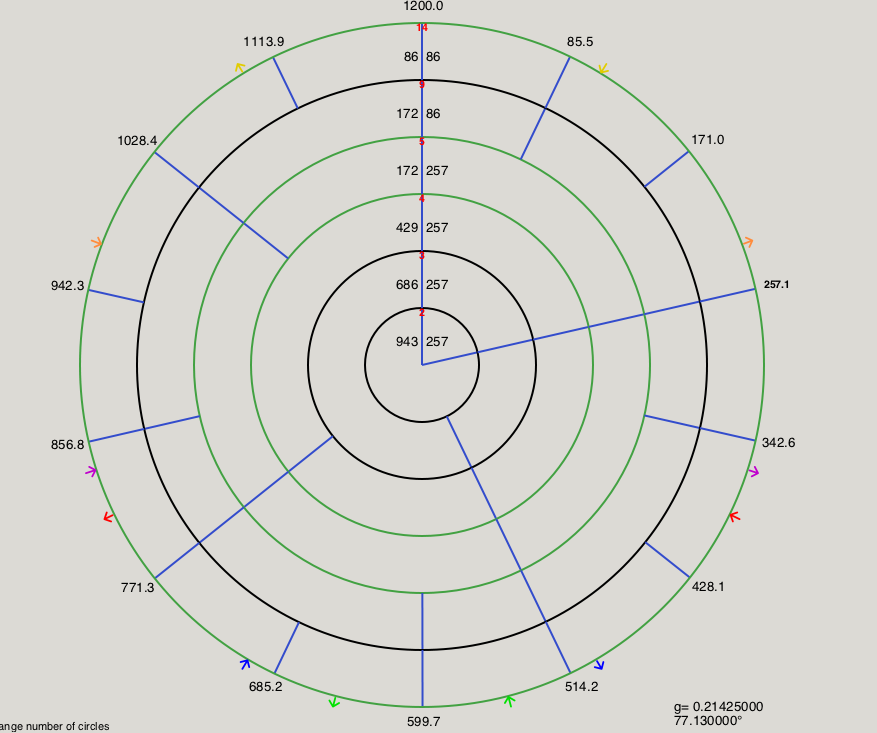
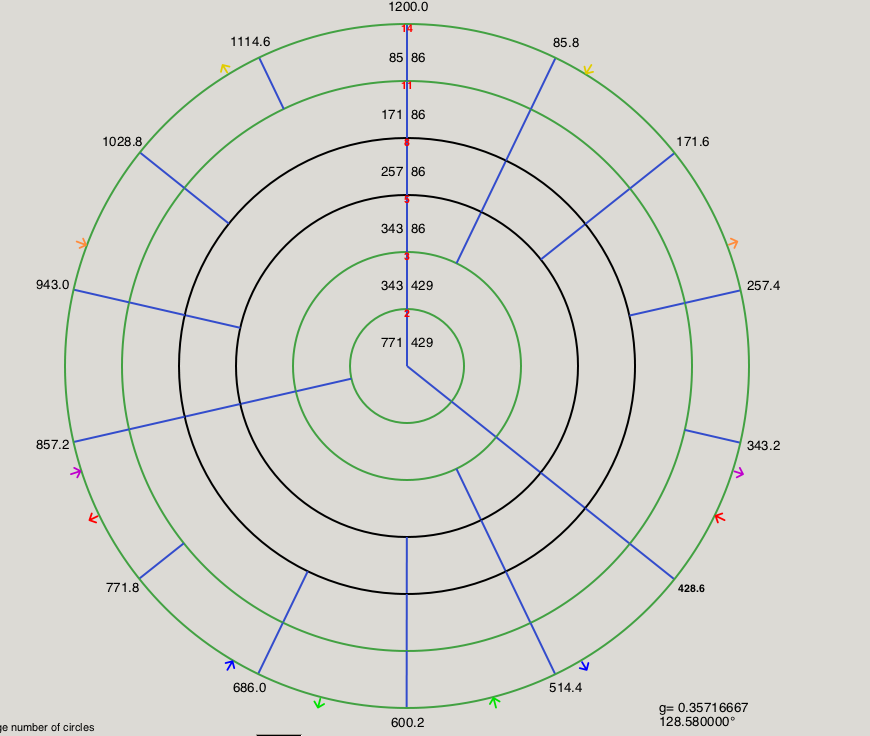
Beep[9]
14edo is also the largest edo whose patent val supports beep temperament, tempering out the chromatic semitone (21:20), and falling toward the "brittle" (fifths wider than in 9edo) end of that spectrum. beep is one of the simplest 7-limit temperaments, although rather inaccurate (the 7:5 is mapped onto 6\14, over 70 cents flat). Its otonal/major and utonal/minor tetrads are inversions of one another, which allows a greater variety of chord progressions (since different inversions of the same chord may have very different expressive qualities). Despite being so heavily tempered, the tetrads are still recognizable and aren't unpleasant-sounding as long as one uses the right timbres ("bell-like" or opaque-sounding ones probably work best). beep forms enneatonic modes which are melodically strong and are very similar to diatonic modes, only with two mediants and submediants instead of one. Beep[9] has similarities to mavila, slendro, and pelog scales as well.
Using beep[9], we could name the intervals of 14edo as follows. The 3, 5, 6, 8, 9, and 11-step intervals are all consonant, while 1, 2, 4, 7, 10, 12, and 13 steps are dissonant. There is no distinction between "perfect" (modulatory) and "imperfect" (major/minor) consonances here; there are enough chords here that root motion may occur by any consonant interval, and thus all six consonances are "perfect" intervals, rather than just two of them as in the diatonic system. As in the diatonic scale, the perfect intervals come in pairs separated by a major second, and with a characteristic dissonance between them; in beep[9] there are three such pairs rather than just one.
- 1\14: Minor 2nd9: functions similarly to the diatonic minor second, but is more incisive.
- 2\14: Major 2nd9: functions similarly to the diatonic major second, but is narrower and has a rather different quality.
- 3\14: Perfect 3rd9: the generator, standing in for 8:7, 7:6, and 6:5, but closest to 7:6.
- 4\14: Augmented 3rd9, diminished 4th9: A dissonance, falling in between two perfect consonances and hence analogous to the tritone.
- 5\14: Perfect 4th9: technically represents 5:4 but is quite a bit wider.
- 6\14: Perfect 5th9: represents 4:3 and 7:5, much closer to the former.
- 7\14: Augmented 5th9, diminished 6th9: The so-called "tritone" (but no longer made up of three whole tones). Like 4\14 and 10\14, this is a characteristic dissonance separating a pair of perfect consonances.
- 8\14: Perfect 6th9: represents 10:7 and 3:2, much closer to the latter.
- 9\14: Perfect 7th9: technically represents 8:5 but noticeably narrower.
- 10\14: Augmented 7th9, diminished 8th9: The third and final characteristic dissonance, analogous to the tritone.
- 11\14: Perfect 8th9: Represents 5:3, 12:7 and 7:4.
- 12\14: Minor 9th9: Analogous to the diatonic minor seventh, but sharper than usual.
- 13\14: Major 9th9: A high, incisive leading tone.
- 14\14: The 10th9 or "enneatonic decave" (i. e. the octave, 2:1).
Others
- 2 2 2 2 2 2 2 - Equiheptatonic (exactly 7edo)
- 2 2 2 2 1 4 1 - Fennec[idiosyncratic term] (original/default tuning)
- 1 4 1 2 2 2 2 - Inverse fennec[idiosyncratic term] (original/default tuning)
- 3 1 4 1 4 1 - Pseudo-augmented
- 1 4 1 2 1 4 1 - Pseudo-double harmonic minor
Diagrams
Software support
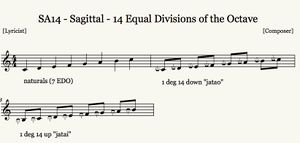
Music
- See also: Category:14edo tracks
See also
Further reading
